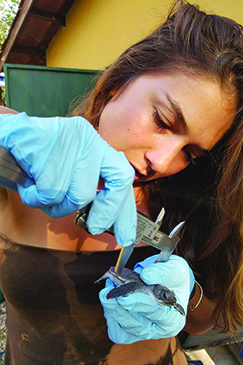プログラム調査日程・空き状況・参加費用等、海外調査に関するお問い合わせは、アースウォッチ・ジャパン事務局にて承ります。info@earthwatch.jp までお気軽にお問い合わせください。
The leatherback sea turtle population in the Pacific, once the stronghold of the species, has decreased by over 90% since 1980. Help scientists investigate this decline and look for ways to save this species.

Many of the remaining Pacific leatherbacks nest in the sands of Playa Grande, Playa Ventanas, and Playa Langosta on the Pacific coast of Costa Rica. Female leatherbacks dig holes with their flippers and lay about 80 round eggs, a process they’ll repeat up to 12 times during the breeding season. In about two months, the fragile hatchlings will emerge.
The world is a dangerous place for these tiny turtles and their parents. They’re threatened by climate change, boat traffic, fishing gear, and humans harvesting their eggs. To truly understand why this ancient species has declined so rapidly and what we can do to stop this decline, researchers need to know everything about them: their behavior, physiology, genetics, population biology, and migration patterns.
To build this knowledge base, you’ll walk the beach at night when turtles are active, getting up close to these massive animals to attach transmitters that will track their local and long-distance movements. You’ll also help relocate eggs from nests in dangerous spots, like somewhere the waves might wash them away, to a hatchery. The researchers on this expedition have studied leatherbacks for over two decades, and you’ll help them expand the longest-running database that exists on Pacific marine turtles. This work is critical: with leatherbacks declining at an alarming rate, each turtle is precious.
HOW YOU WILL HELP
When you arrive, the researchers will provide you with information on working with pollinator species. Depending on your team’s location, field work includes the following tasks:
.
You’ll do much of your work at night, when the turtles haul themselves up onto the beach to lay their eggs. A rotating group of team members will work for five or six hours each night and will have time to sleep during the day, when the other group of volunteers goes out. You and your teammates will help:
.

OBSERVE AND MONITOR NESTING LEATHERBACKS
Those working on the beach at night will visit each nesting leatherback to take measurements and record any unusual markings or injuries—in other words, you’ll get as close as a person can to these majestic animals..
.
.
.
.
RELOCATE SEA TURTLE NESTS (OCT.-MID-DEC.), RELEASE HATCHLINGS IN OCEAN (MID-DEC.-FEB.)
Early in the breeding season, you’ll check for nests that are in danger of getting washed away, then relocate the eggs in those nests to a hatchery where they can incubate safely. From mid-December to February when babies start to emerge from the eggs in the hatchery, these teams will take the tiny turtles down to the water’s edge and release them into the wild.
SURVEY THE BEACH
During the day, teams will count sea turtle nests on the beach, take nest temperatures, and look for signs of erosion that could put nests in danger..
